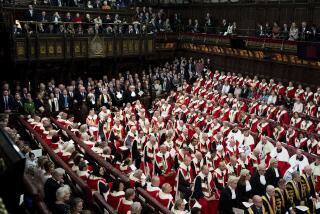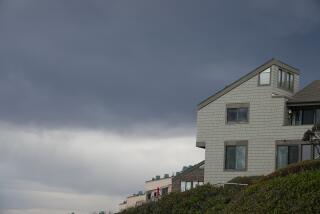Estates Mostly Intact : Aristocratic Families Still Own London
- Share via
LONDON — Three centuries ago, the parents of a mousy 12-year-old gave up 300 acres of London real estate as a dowry in order to marry her to an eligible young aristocrat. This was no surprise as wealthy families owned most of 17th-Century London.
Some may find it surprising, though, that 300 years and a social revolution later, many of these same families still have vast holdings in London. They are among the world’s wealthiest private urban landowners.
The property of these people--a handful of earls, dukes and marquesses--is valued in the billions of dollars. It stands as testimony to the survivability of the aristocracy.
It stands, too, as a monument to the strength of English common law and its principle of primogeniture, which ensures that a family fortune passes undivided to the oldest son.
Mary’s Bequest Intact
By way of illustration, the sixth Duke of Westminster, a descendant of 12-year-old Mary Davies, today owns nearly the same 300 acres she brought to the family so long ago. His holdings include nearly half of London’s Mayfair district and most of nearby Belgravia--enormous wealth that is a bit like owning half of Beverly Hills or most of Greenwich Village.
Estates owned by the Earl Cadogan, the Duke of Bedford, the Viscount Portman and Lord Howard de Walden extend over wealthy areas of the city much as they have for generations.
The waves of property investors that wash over the city, mostly from the Mideast these days, have pushed land values ever higher, adding to the financial security of these estates rather than posing any threat to their existence.
Many foreigners have leased property from them, but few have managed to buy any of the land outright.
In Return, Florida Land
When Lewis Douglas, the U.S. ambassador to Britain in the late 1940s, inquired about buying land in Grosvenor Square for a new and larger embassy, the second Duke of Westminster thought about it for a while and then offered a trade.
The Americans could buy the land, he decided, only if they agreed to return 1,200 acres of prime Florida real estate that had been given to the duke’s family in the 1700s as a royal grant but confiscated after the Revolutionary War.
Douglas politely declined the offer, and the embassy here continues to be one of the few the United States has that does not stand on land owned by the U.S. government.
With few exceptions, London’s land barons are very private individuals who avoid the limelight, spending much of their time at their country houses.
For example, the seventh Earl Cadogan, now in his 70s, is at his country estate in Scotland, where he breeds racehorses, more often than he is at his apartment above the Cadogan Estate office in London.
Most of these people “are ordinary landed aristocracy and deeply uninteresting,” according to Simon Jenkins, author of the book “Landlords to London,” which traces their role in the city’s development. Many of them talk of “farming” their London properties, looking upon the lucrative rents as a rich, reliable urban harvest.
Among the few who are consistently visible is the 32-year-old Duke of Westminster, who serves as a patron to numerous charities, including the Salvation Army and the Society for the Prevention of Cruelty to Children.
The duke, who spent a year in western Canada and Australia as a wandering cowboy and who once wanted to be a professional soccer player, now devotes his energy to managing his properties, commuting between London and his 4,500-acre estate in a helicopter that bears the family crest.
Since the early 1900s, when Britain’s first Liberal Party government took up the cudgels for reform, the titled rich have been under the threat of being wiped out by new tax laws, yet they have shown a remarkable ability to sidestep out of harm’s way.
Link Up With Developers
Behind corporate fronts and interlocking family trusts, they have joined forces with property development companies and pension funds to protect and expand their holdings.
“These estates are now indistinguishable from any other property investment companies,” Jenkins said. “The fact they are related to old family lines is fortuitous.”
John (Jimmy) James, executive trustee of the Duke of Westminster’s Grosvenor Estate, put it this way: “We put a lot of effort into it. We have to get up a bit earlier and stay ahead of the game.”
In recent years, the Duke of Westminster, operating either independently or with a group of pension funds, has put together shopping centers and urban redevelopment projects and has acquired overseas holdings valued at $1.3 billion, including 1,200-acre Annacis Island near Vancouver, a half-interest in the 48-story Wells Fargo Building in downtown Los Angeles and 17 acres of development land at the edge of the Silicon Valley.
“Our overseas investment activities have grown quickly,” James said, “but London is still the engine room of the estate.”
The Earl Cadogan has also diversified, purchasing buildings in other British cities and land in western Australia and the United States. He has also bought into traditional British industries, including Christie, one of Britain’s last makers of men’s hats, and a large firm that makes scarfs and neckties.
“We are an expanding enterprise,” Dennis H. Bedingham, the director of Cadogan Estates Ltd., said.
Controlled the Uses
The landed aristocrats were at the apex of their power in the 18th and 19th centuries. More than any government, they determined the course and style of London’s development. They parceled out their property for development on 99-year leases, all the time retaining tight control over what would be built and who the occupants would be.
If a development turned sour, the builder might go bankrupt but the landowner lost virtually nothing. If it went well, the builder collected a short-term windfall but the estate owner reaped the long-term benefits.
In a combination of vanity and hard business sense, the land barons demanded the highest standards for their properties--which they looked on as showcases for their personal prestige.
The Duke of Bedford, whose estate once included most of Bloomsbury, the old London literary area that is home to the British Museum, specifically excluded butchers, bakers, brewers, second-hand shoe salesmen and bone boilers from a list of acceptable occupants.
The Earl Cadogan maintained such strict rules against commercial enterprise that a dentist who wanted to set up his practice in a room of his own residence could not get permission to do so until lease terms were liberalized after World War II. The 18-story Carlton Towers hotel is now one of the earl’s tenants.
Tenancy agreements have been substantially eased in recent years, but an early Duke of Bedford’s prejudice against public bars still makes it difficult to find a drink in the Bloomsbury area.
All the estate owners have insisted on stringent upkeep of their property, reserving the right to immediately evict anyone judged to be in violation of the lease.
“No Mogul monarch, no Persian satrap was ever harder on a conquered people,” Fred Banfield observed in his 1888 history of London’s landowners.
When the London Brighton and South Coast Railway wanted to push track through to the doorstep of Buckingham Palace and build Victoria Station, the Duke of Westminster reluctantly granted his approval but insisted that the rail line be completely roofed to prevent any unsightly soot from locomotives settling on the houses of Belgravia, and that the track be placed on rubber shock absorbers to minimize noise and vibration. The railroad complied.
The refusal of other aristocratic landowners to let the railroads pass through their estates is one reason why most of London’s principal train stations are situated far out on the periphery of the city.
No Royal Grandeur
Historians blame the landowners for London’s lack of grand, awe-inspiring avenues such as those that grace so many large European cities.
“Thoroughfares such as the Champs-Elysees or the Unter den Linden were royal or state projects, but here royalty didn’t have that power,” according to Peter Gotlop, the Greater London Council historian. “The real power in London lay with the landed families, and they had little interest in anything outside their own estates.”
Still, the rigid rules established by the landed aristocracy have provided the city with a rich architectural legacy, as well as some of Europe’s finest early examples of urban planning. Preservation and continuity of development are still emphasized.
“We are a force for good,” James insisted. “We’ve provided a continuity of good standards over many years.”
The estates still maintain strict controls on the appearance of their property, including the condition and color of building exteriors, size and shape of commercial signs and the size of television antennas.
The power of the estate owners began to wane in the 1870s and 1880s as the influence of the railroads and shifting population patterns eroded the value of estates in the city’s eastern and northern areas.
In the first two decades of this century, the impact of reformist legislation, of World War I and of the postwar Depression combined to take their toll.
The Duke of Bedford was forced to sell Covent Garden, and other, smaller estates began breaking up, too, under the strain. Poorly managed estates that had permitted standards to slip were the first to crumble as rents declined, poorer-class tenants moved in and property values fell.
Effect of Inheritance Taxes
Inheritance and other taxes, and simple fatigue, eroded more of the landed estates in the years just after World War II. Lord Howard de Walden sold much of the north side of Oxford Street, home of London’s premier department stores, and taxes of more than $30 million after the death of the seventh Viscount Portman forced his heirs to sell nearly two-thirds of their land in central London.
In the 1950s, the Grosvenor Estate sold parts of the Pimlico district, just west of Parliament, in order to pay $50 million in inheritance duties after the second Duke of Westminster’s death.
Since then, however, the protection of trusts and other tax shelters have shielded the estates, but the possibility of future legislation, such as a crippling tax on wealth, remains a constant threat.
A law enacted in the 1960s, granting the right of purchase to long-term tenants of lower-value properties, has created a few minor holes in some estates.
However, parliamentary action to expand tenant purchase rights could break up the large estates.
“There has been a trend of such legislation since the beginning of the century,” Bedingham, the Cadogan Estates director, said, “and in the end, it remains the ultimate threat.”
Still, few can conceive of London moving into the 21st Century without the landed estates that have shaped its growth over the last three centuries.
And no one doubts that the aristocracy still has the ability to overcome adversity. When the present Duke of Westminster crashed the family’s light plane into a muddy Irish field a few years ago, nearly killing his mother as well as himself, his mother emerged from the wreckage saying:
“If we’re going to make a habit of this, I must wear my boots.”
More to Read
Inside the business of entertainment
The Wide Shot brings you news, analysis and insights on everything from streaming wars to production — and what it all means for the future.
You may occasionally receive promotional content from the Los Angeles Times.










